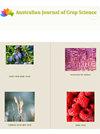Selection of F3 populations of Capsicum annuum for greenhouse production
Q3 Agricultural and Biological Sciences
引用次数: 0
Abstract
Capsicum annuum is one of the most important plant species in the world. México has the greatest diversity for this plant. However, its production is limited due to the scarcity of improved varieties for greenhouse production. Therefore, the development of high-yield varieties would be possible through the genetic recombination of native varieties (Creole populations) and superior cultivars. Therefore, the purpose of this research work was to assess and select outstanding F3 populations for greenhouse production. The work was carried out in a greenhouse at Saltillo, Coahuila Mexico in 2018, involving 8 parents, in which 3 varieties were used as female (pollen-receptor plants), 5 varieties as males (pollen-donor plants) and 9 F3 populations derived by selfing from 9 F2 populations. The parents and F3 populations composed 17 treatments that were established in a greenhouse under a randomized block design with three replications. The variables were total fruit yield, average fruit weight, total number of fruits per plant, ascorbic acid content, total capsicinoids, days to flowering, days to harvest, final plant height, and basal stem diameter. Significant differences were found in all variables of F3 populations. The highest RTF (total fruit weight) belonged to P1,4 and P1,6, with1647.0 and 1652.0 g/plant, respectively. In terms of CAA (ascorbic acid content), population P2,4, was significantly superior to the rest of the genotypes and exceeded the best parent by 19.8%. We concluded that populations P1,4, P1,6 and P2,4 may be uased to develop cultivars with high yield and high quality for greenhouse production.大棚生产辣椒F3居群的选择
辣椒(Capsicum annuum)是世界上最重要的植物之一。这种植物在墨西哥的多样性最大。然而,由于温室生产的改良品种稀缺,其产量受到限制。因此,通过本地品种(克里奥尔群体)和优良品种的遗传重组,培育高产品种是可能的。因此,本研究工作的目的是评估和选择适合温室生产的F3优良种群。该研究于2018年在墨西哥科阿韦拉州萨尔提略(Saltillo)的一个温室中进行,涉及8个亲本,其中3个品种为雌性(花粉受体植物),5个品种为雄性(花粉供体植物),9个F3群体由9个F2群体自交而来。亲本和F3群体组成17个处理,按随机区组设计,在温室中建立3个重复。变量为总果产量、平均果重、每株果实总数、抗坏血酸含量、总辣椒素、开花天数、收获天数、最终株高和基茎粗。F3群体各变量差异均有统计学意义。果实总重最高的是P1、4和P1、6,分别为1647.0和1652.0 g/株。在CAA(抗坏血酸含量)方面,群体P2、4显著优于其他基因型,比最佳亲本高出19.8%。综上所述,P1、4、P1、6和P2、4群体可用于培育温室生产的高产优质品种。
本文章由计算机程序翻译,如有差异,请以英文原文为准。
求助全文
约1分钟内获得全文
求助全文
来源期刊

Australian Journal of Crop Science
农林科学-农艺学
CiteScore
1.20
自引率
0.00%
发文量
75
审稿时长
3.5 months
期刊介绍:
Information not localized
 求助内容:
求助内容: 应助结果提醒方式:
应助结果提醒方式:


